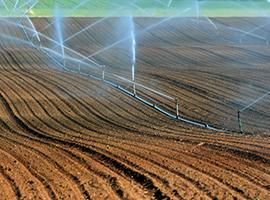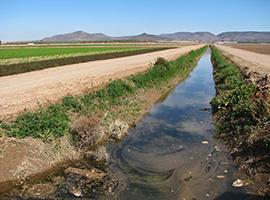There's a very obvious and direct use for measurements of soil moisture. It allows the need for irrigation to be quantified in advance of a crop showing signs of distress. Knowing the soil moisture status enables highly efficient irrigation, providing the water as and when required, and eliminating the wasteful use of water when irrigation is not needed.
There are, however, other reasons for measuring soil moisture that concern our understanding of how our natural environment functions and how it responds to change.

In defining what soil is we previously noted that soil is seen as a medium in which plants grow. Roots can penetrate soil so that the plant can anchor itself and also so that it can access the nutrients and water stored in the soil. The availability of water held in the soil is essential for vegetation to grow. In a natural landscape the vegetation will be suited to the soil type, the climate, and also the soil moisture regime. The soil moisture regime means the way in which the moisture content varies within and between years. When there is too little water, i.e when soil moisture falls below the wilting point, plants struggle to survive. Similarly, too much water can be equally fatal. The availability of water is one of the major factors controlling the biogeography of plant species.
We've also seen that the microbes in the soil are essential for the conversion of plant material into soil nutrients required by other soil organisms and plants. There is evidence to suggest that the microbial community will also, indirectly and directly, reflect the soil moisture regime.
Water entering the terrestrial environment as rain will often drain through the soil entering the ground water, which ultimately leads to either streams, rivers, lakes, wetlands or the ocean. This process can be fast, taking hours to days (e.g. in a thin soil on a steep slope) or extremely slow, perhaps taking thousands of years, if the water drains down into a large aquifer. So the soil acts as part of a storage system that regulates the passage of water from rainfall arriving at the land surface to its return to the sea. This storage means that some rivers continue to flow long after rain has stopped falling, perhaps for months or even years. The pattern of river flows (i.e. the particular combination of high and low flows) will itself support communities of flora and fauna that are adapted to this particular pattern of variability.
We've also noted that moisture held in soils can 'short circuit' the water pathway discussed earlier and be returned directly to the atmosphere by evaporation and the evapotranspiration of plants. This returning moisture can itself affect the local weather.
So the more we understand about soil moisture the better able we are to recognise the plants that are suited to particular conditions, the availablity of water to maintain suface waters, and the impacts soil moisture can have on our weather. This understanding becomes more interesting and useful when we want to understand the impacts of modifying and exploiting our environment.
Two such environmental modifications are extremely old and were well established in ancient civilisations. Firstly, native vegetation was replaced by crops through intensive agriculture. Secondly, water was withdrawn from rivers and aquifers for domestic supply and irrigation. Through time, these modifications have become larger and more widespread, and as a consequence so have the impacts. Let's just consider two of these, irrigation and land drainage.
Irrigation adds water to the soil to ensure cultivated plants have enough water to remain healthy. This water needs to be obtained from some other location, stored and transported, so while some soils will be wetter, others might become drier. The applied water will increase evapotranspiration, perhaps meaning less water is available downstream, and possibly affecting the local climate by altering energy and water transfers between the land surface and the atmosphere.

Land drainage, on the other hand, usually has the objective of removing excess water from the soil to make it more suitable for agriculture. Depending on the local conditions this can either increase storage capacity in the soil to reduce the flood response on the land to heavy rainfall, or provide a rapid pathway for water to move downstream.
The important point here is to remember that any change to any part of this system will have an effect; this effect can be easily understood, minor, short-lived and reversible, or unexpected, major and irreversible.
Understanding, and predicting the effects of climate change are key concerns. Will these impacts change the water availability for agriculture, industry, domestic consumption and the environment? Measuring soil moisture and developing knowledge of how it varies between places and through time is fundamental to gain an insight into likely future conditions.
Previous: What is soil moisture?
